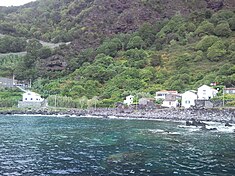Manadas
| Manadas | |
| Santa Bárbara | |
| Civil Parish | |
|
A coastal perspective of the Fajã das Almas in the parish of Manadas
|
|
| Official name: Freguesia de Manadas (Santa Bárbara) | |
| Name origin: Portuguese for herds of cattle | |
| Country | |
|---|---|
| Autonomous Region | |
| Island | São Jorge |
| Municipality | Velas |
| Localities | Fajã das Almas, Ladeiras, Manadas, Ponta das Casteletes |
| Landmark | Fajã das Almas |
| Center | Manadas |
| - elevation | 114 m (374 ft) |
| - coordinates | 38°38′5″N 28°5′46″W / 38.63472°N 28.09611°WCoordinates: 38°38′5″N 28°5′46″W / 38.63472°N 28.09611°W |
| Highest point | Pico de Esperança |
| - elevation | 1,053 m (3,455 ft) |
| - coordinates | 38°40′9″N 28°7′19″W / 38.66917°N 28.12194°W |
| Lowest point | Sea level |
| - location | Atlantic Ocean |
| - elevation | 0 m (0 ft) |
| Area | 11.20 km2 (4 sq mi) |
| - water | .01 km2 (0 sq mi) |
| - urban | .20 km2 (0 sq mi) |
| Population | 374 (2011) |
| Density | 33/km2 (85/sq mi) |
| Settlement | c. 1559 |
| LAU | Junta Freguesia |
| - location | Caminho de Baixo |
| - coordinates | 38°38′6″N 28°5′59″W / 38.63500°N 28.09972°W |
| President Junta | António Manuel da Silveira Azevedo |
| President Assembleia | José Maria da Silva Ávila |
| Timezone | Azores (UTC-1) |
| - summer (DST) | Azores (UTC0) |
| Postal Zone | 9850-026 |
| Area Code & Prefix | (+351) 292 XXX-XXXX |
| Demonym | Manadense |
| Patron Saint | Santa Bárbara |
Manadas, once locally known as Santa Bárbara, is a civil parish in the municipality of Velas in the Azores. The population in 2011 was 374, in an area of 11.20 km².
Santa Bárbara was one of the older parishes on São Jorge, probably founded before 1550, when 250 inhabitants lived in the parish and when it began appearing in documents during the 16th Century. In 1568, it was included in a listing of six religious parishes that occupied the island of São Jorge. At the time of its founding, it included an area vastly larger than its current borders with the communities of Urzelina, Terreiros and Fajã das Almas lying within its borders.
At the beginning of 18th Century the population had grown to 500 residents.
The Port of Manadas was marked by a lookout's hut, constructed in 1647, to monitor shipping the São Jorge Channel. During the era of piracy, the locals would hang supposed pirates from this vantage point, as a warning to pirates or privateers of the consequences of attacking the village/municipality. Years later, the area of Manadas was the location of the Fort of Urzelina, which was used to protect the area. During the Orange Cycle (the economic period where local farmers produced citrus fruits for export) the lookout was used to warn of the arrival of cargo ships, and alerting them to have their produce in port for shipment. Later, the port was also the staging port for exports of Castelete wines to the European continent and England.
Manadas was the birthplace of the ethnograph João Teixeira Soares de Sousa, who greatly contributed to the histo-cultural development of the island.
The parochial Church of Santa Bárbara was constructed over an older temple that dated to the 15th Century. The remodelled architecture, which dates back to the 18th Century, includes rare golden ornamentation and is one example of the Baroque-style, popular in the Azores. Classified a national monument, it remains unaltered since its construction; includes original azulejo (dedicated to local quarrymen), its golden altars, an original roof (built with cedros) and original sacristy. In addition, the parish is populated with several other historical religious sanctuaries: Chapel of Santa Rita de Cássia, Chapel of Senhora da Guadalupe and Chapel of Santo Cristo.
Located 15 kilometres from the municipal seat of Velas, on the municipalities southern border with (Calheta); it is delimited by the São Jorge Channel (on the southern coast), the civil parish of Urzelina (along the Ribeira Large) and the ridge of Pico da Esperança (in the civil parish of Norte Grande.
...
Wikipedia

